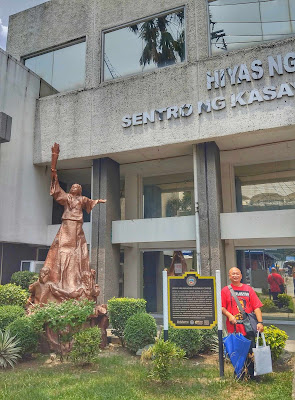The Province of Bulacan has always been a treasure trove possessing loads of aspects mostly related to the history of the Philippines.
Situated in Central Luzon, Bulacan takes pride in being the birthplace of various noble heroes, as well as locations of pivotal events that have shaped the course of the archipelago, as evidenced by the numerous local holidays occurring annually in order to help preserve this region's culture and promote national identity.
As far as heritage is concerned, we could not discount the fact that aside from the above-mentioned facets, old structures reflecting the past should also be taken into account since they also immensely exude historical and cultural value, quietly assuming the role of silent storytellers.
Launched way back May 9, 2023 by the Provincial History, Arts, Culture, and Tourism Office (PHACTO) located at the Hiyas ng Bulacan Cultural Center in Malolos, Bulacan, and implemented on December 1, 2023, the "Bulacan Pamana Pass" is basically a guide to 20 heritage structures in the province, such as the Barasoain Church, specifically aimed for the local tourist market.
 |
| Bulacan Pamana Pass |
For those who are interested to embark on this journey, the mechanics of which is that, for every tourist attraction visited on a given destination, make sure that the Pass be stamped, verifying your site presence after showing photo evidence at an assigned Tatak Center.
As an avid heritage advocate, I started my trip last August 19, 2024 and ended December 19, 2024. Here was the chronological order on how I completed the Pamana Pass experience, but first things first, participants must visit the Hiyas ng Bulacan Cultural Center, accomplish a Registration Form, and sign a Waiver before officially claiming the Pass. Claiming only happens on weekdays from 8:00AM - 5:00PM.
Structure #1: Hiyas ng Bulacan Cultural Center (Malolos)
Inaugurated on August 30, 1971, this serves as the center of Bulacan's history, arts, culture, and tourism.
 |
| Hiyas ng Bulacan Cultural Center |
Structure #2: Kapitolyo ng Bulacan (Malolos)
Built in 1930.
 |
| Kapitolyo ng Bulacan |
Structure #3: Simbahan ng Barasoain (Malolos)
- Built in 1885.
- Malolos Congress held here on September 15, 1898.
- First state university founded here on October 19, 1898.
- Site of the First Philippine Republic inaugurated here on January 23, 1899.
 |
| Simbahan ng Barasoain |
Structure #4: Casa Real de Malolos (Malolos)
- Former office of the Gobernadorcillo during the Spanish colonial period.
- Demolished in 1965 and restored in 1980.
 |
| Casa Real de Malolos |
Structure #5: Aguas Potables de Malolos (Malolos)
Built to provide clean drinking water to downtown Malolos in 1923.
 |
| Aguas Potables de Malolos |
Structure #6: Katedral ng Malolos (Malolos)
- Founded by the Augustinians in 1580.
- Convent functioned as the Presidential Palace of Gen. Emilio Aguinaldo in 1898.
 |
| Katedral ng Malolos |
Structure #7: Tahanan ni Dr. Luis Uitangcoy Santos(Malolos)
- Built in 1933.
- Once a clinic for the wounded during World War II.
 |
| Tahanan ni Dr. Luis Uitangcoy Santos |
Structure #8: Saint John of God Parish (San Rafael)
 |
| Saint John of God Parish |
Structure #9: Saint Augustine Parish (Baliwag)
- Built from 1769 to 1774.
 |
| Saint Augustine Parish |
Structure #10: Diocesan Shrine and Parish of Saint John the Baptist (Calumpit)
Founded in 1572, it is the oldest church in the Province of Bulacan.
 |
| Diocesan Shrine & Parish of St. John the Baptist |
Structure #11: Alberta Uitangcoy House (Malolos)
- One of the Women of Malolos who petitioned to establish a school for women in 1888.
- Built in the late 19th century.
 |
| Alberta Uitangcoy House |
Structure #12: Diocesan Shrine and Parish of Nuestra Señora de la Asuncion (Bulakan)
- Built in 1885.
- Spanish forces in this church surrendered to Gen. Gregorio del Pilar, paving the way to the liberation of Bulacan in 1898.
 |
| Diocesan Shrine & Parish of Nuestra Señora de la Asuncion |
Structure #13: Saint Francis of Assisi Parish (Meycauayan)
- Built in 1668.
- Notable for its isolated bell tower connected by a bridge.
 |
| Saint Francis of Assisi Parish |
Structure #14: Old PNR Meycauayan Station (Meycauayan)
- Built in 1891.
- Witnessed battles between Filipino revolutionaries and Americans invaders (1899-1901) and the Japanese forces (1942-1944).
 |
| Old PNR Meycauayan Station |
Structure #15: Constantino Ancestral House (Balagtas)
- Built in 1840.
- Jose Rizal stayed here when he visited Malolos in 1892.
 |
| Constantino Ancestral House |
Structure #16: Old PNR Guiguinto Station (Guiguinto)
- Built in 1891.
- Site where the uprising of 200 Katipuneros against the Spaniards took place on May 27, 1898.
 |
| Old PNR Guiguinto Station |
Structure #17: Old Municipal Building (Baliwag)
Built in the late 19th century.
 |
| Old Municipal Building |
Structure #18: Santiago Apostol Parish (Plaridel)
- Founded in 1602.
- Known for the onion-shaped pediment that resembles the mosque of Muslims, drawing inspiration from Saint James the Moor-slayer.
 |
| Santiago Apostol Parish |
Structure #19: Cemetery Chapel of Quingua (Plaridel)
Served as a mortuary chapel of the old parish cemetery or camposanto of the town of Quingua (now Plaridel).
 |
| Cemetery Chapel of Quingua |
Destination #20: Gabaldon School (Pulilan)
- Built in 1908.
- First primary school in Pulilan during the American era.
 |
| Gabaldon School |
Awarding of Tokens and Certificate (Malolos)
Hiyas ng Bulacan Cultural Center in Malolos, Bulacan on December 23, 2024.
 |
| Posing with Billy Joe B. Marciano (History Coordinator, PHACTO) |
Congratulations po!
ReplyDeleteWOW 😍😍 CONGRATS PARDS!! 🥳🥳
ReplyDeleteYaayyy wow 🤩
ReplyDelete